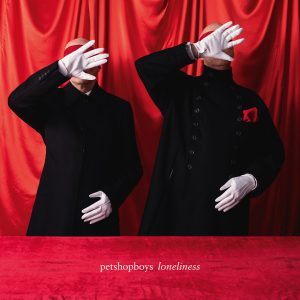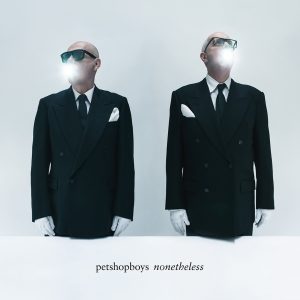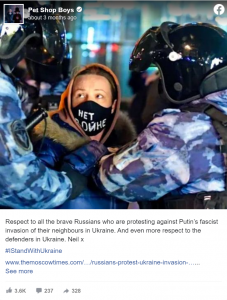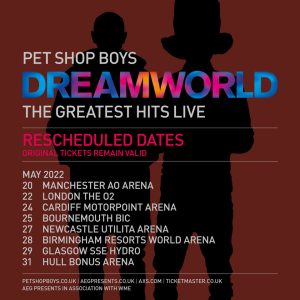This discussion between Pet Shop Boys Neil Tennant and Chris Lowe, with their producer Stuart Price, took place as the three sat down to listen to a vinyl test-pressing of new album Electric. Track by track, this is what they had to say about it.
The idea of a “return to form” seems a ill-fitting concept for a band with 28 years, 22 top tens and 12 albums on the clock. Yet, for those who hold up their imperial age (’80s to mid-’90s) as being responsible for some of the greatest pop music ever made, a new record by Neil Tennant and Chris Lowe is always a huge event, and—the odd humdinger of a single aside (2004′s “Flamboyant”, say)—an exercise in mild disappointment. It’s was with uncapped joy, then, that we presented the video premiere of “Vocal”, a return to their dance music roots after the more middle-aged ruminations of Elysium. However, in the spirit of all PSB’s work, the dancefloor isn’t the only muse at play on Electric—there’s always a Che Guevara to every disco beat. Michael Gambon, Berlin, David Lodge, Bolshevism… the list of references in Electric might take some close reading to unpick. Who better than to guide you through than the Boys themselves alongside producer Stuart Price? This exclusive track-by-track is the record in their words.“Axis”Neil Tennant: Now this track is just called “Axis” but it has also been called at various times “Electric” and “Turn it On”, but it went full circle back to “Axis”.Chris Lowe: We’d been to an Italian disco night in Berlin and got back and felt inspired by the music we’d been listening to—nothing specific, but just the feeling of it all.NT: And I think it was this track that might have made us decide to do a separate dance album— ‘cause this was never going to go on Elysium. There was no option of that at all.Stuart Price: The demo always had the direction and the atmosphere. I sort of always thought it had this sort of futuristic, sort of mystical “City in the Skies” feel to it, and that’s what I loved about it. It was sort of like where techno met disco… and that’s always what it felt like, so when we were working on it in the studio I think it was just putting it into a place where it could be played in a DJ set now. The BCS-3 is that box you always see Eno with in a Roxy Music video, or on a Bowie record. And there’s not really anyone alive that can play it, but anyone can sort of stand there and just push it and it will do something. So all this, it’s just the sound of those boxes—plus disco bells, equals “Axis”.NT: The disco bell making its first of many appearances on this album. “Bolshy”SP: Russia.NT: Russia. The new Russia. Bells. It’s “Bolshy”.SP: That’s why I thought it could be brilliant. It’s a really ridiculous sort of song.NT: We went to Berlin to write—we’re always going to Berlin to finish off the Alan Turing piece. Anyway, as ever, we hadn’t finished it – but we immediately wrote this… erm, I can’t even remember why.CL: Oh, because I’d read this thing where there’s this technique where you program the same lines on loads of different sounds, and you just flip between them all, and I thought, “Oh, I’ll have a go at that,” just to see how it turns out. So it’s just an experiment really, and that’s how this song came about. And also you go to the chorus in a funny time. It’s really weird.NT: You know in English English ‘bolshy’ means ‘awkward’ but it comes from the word Bolshevik— you know, Communist—and so when making the record we put a load of Russian stuff on it.CL: It’s a cool track this, isn’t it? It sounds very cool to me.SP: Yeah—telephone, Google translation…NT: I’m sure we’re gonna get inundated with emails telling us the Russian’s all wrong. Not our fault!SP: I think those handclaps, it’s a sort of foundation of a lot of your music, isn’t it?CL: We’ve always liked them.NT: It certainly used to be, yeah. It’s a party-sized helping of handclaps. [laughs]SP: It’s sort of where the disco is, isn’t it? “Love is a Bourgeois Construct”NT: This was written after Elysium, but before “Bolshy”. Actually this is also written, I think, while we were doing “Alan Turing”, probably.SP: We sort of added those strings.CL: Classic Stuart Price style! [laughs]NT: I love the way it all comes banging in. SP: It’s just in that vein of anthemic Pet Shop Boys music.CL: Particularly when you get those “whoah oh oh ohs” thrown in for good measure.NT: It’s funny singing this live, which we were doing in rehearsals this week. It’s in a very different vocal range from “It’s a Sin” or something. It’s quite conversational. It’s quite difficult to EQ live, because it’s a sort of conversational part of my voice. And the lyric was inspired by a novel by David Lodge called Nice Work, in which a university lecturer in English has to shadow, for a project, a guy who runs a factory in Birmingham. And he falls in love with her, and she tells him that love is a bourgeois construct.CL: Not “concept”.NT: Not, as some people have wrongly said, “concept”. (laughs)CL: Also it’s a giddy-up bass-line, which we haven’t had for a while. “Fluorescent”NT: The last song we wrote.SP: We never sat together and worked on this.CL: No, we were in Berlin, and you were in Los Angeles. And also we thought the album should have nine tracks.SP: Yeah. I think that’s the thing—Electric started off as an idea to do a dance record, which became, “We’re doing a dance mini album,” which became, “We’ve done an album.”NT: Yeah, exactly. It became the Pet Shop Boy’s 12th album. Which is not necessarily how it started. One morning I woke up and I had three emails from Chris with ideas for tracks he’d done at home, all of which I liked.CL: It was called “Fluorescence”.NT: “Fluorescence”. So I sent it back to Chris and said, “Why don’t we make this the ninth track on the album?” And then we did quite a lot of work on this: put the vocal on, turned it into a song, really.CL: Then Stuart added this really great line which to me sounds like it was inspired by Visage.SP: I think it reminded me of some of the things that came out on Trax records from Chicago. Yeah, it’s funny, it’s almost like you sort of set yourself free of that traditional intro/verse/bridge/chorus, and all of a sudden…CL: Well, a lot of great dance music just has good bits, doesn’t it? It doesn’t bother with the rest, it just has good bits followed by good bits and it dispenses with anything boring that’s gonna get in the way, you know like…SP: Like a bridge.CL: Like a bridge!NT: Originally, this had a whole load more lyrics and we thought we’d finished it, but we decided not to send it to you in case we changed our mind about it. And the following morning we came in and totally simplified it…SP: Ah, okay.NT: Cut at least half the lyrics out of it. And made it a bit more hookier. But “incandescent” survived.CL: But also you want all these instrumental bits.SP: There’s no point covering them all up.NT: I can use the other lyrics in another song. Good, that’s “Fluorescent”. Bit new romantic, that. “Inside a Dream”NT: [to Stuart] You put this start on.CL: There’s something kind of gothic about this.SP: It is. I think “Inside a dream” is one of those tracks where the music sounds like the title. The music sounds like you paint it and you put it together with that in mind. And it begins and ends with these, I feel like they’re sort of kinda deep house sections.NT: More bells—my favorite bell line on the album is on this.SP: These kind of tracks, again, they’re made in a way you want to be able to play them out, and like a lot of good club music, you find your own meaning when you hear it in a club. You hear a lyric and it connects with you, and that’s it. It’s as simple as that, and again it’s about not being over-thought. Actually, a lot of times in a nightclub, when it’s really good dance music being played, all of a sudden when a song comes along, it can just be a bit of a turn-off.NT: Yes.SP: You can suddenly go from being, feeling good in a club, to like…CL: There’s too much information for your brain to assimilate…SP: And it goes a bit Top 40…CL: ‘Cause dance music’s not about that, is it? Dance music’s about repetition. This was just that.NT: Chris and I used to have a songwriting technique where, believe it or not, we used to pretend we were Marvin Gaye. And Marvin Gaye always, or often, used to sing behind one of his own vocal lines, like improvise around it. So, remember this started off singing around the original vocal and then we took the original vocal out, just leaving this. “The Last to Die”NT: This came about by doing a Bruce Springsteen song, because Chris’s sister told Chris she’d discovered a really good Bruce Springsteen song and she thought he would like it, so we played it in the studio and immediately started doing a version of it. And what we really liked about it was the fact that there was a guitar riff, which we thought would make a good synth riff, and then we ended up making it a vocal riff. But it’s the SONG, the music and the melody of the song which definitely lend itself to sort of Pet Shop Boys, four-on-the-floor.CL: It’s great though, it’s got real emotion, combined with four-on-the-floor.NT: It’s very anthemic, isn’t it?CL: I think that’s the thing about working sequentially on the record the way we did, is that we knew things like this were coming up. At some point, and doing it. But you knew it would have its time to do it. So everything we did before, we just did it in order, without pushing things to the front or to the back. “Shouting in the Evening”NT: There’s a quote by the British actor Michael Gambon, who was asked to describe what he did for a living—as an actor obviously—and he said, “Shouting in the evening!” And the lyric is actually really taken from Lionel Richie “Dancing on the Ceiling”: ”Oh what a feeling/shouting in the evening.” [laughs] No really, it’s, “Oh what a feeling/When you’re dancing on the ceiling.” And also, what was great about this, what with its unusual structures, as the lyricist I didn’t have to come up really with many more lyrics. Amazingly enough, we’d never done “What? What? What? What?/When? When? When? When?/Why? Why? Why? Why? /Now. Now. Now. Now.” So that went in. The vocal manipulation, this was done by Chris, in fact.SP: Really?NT: Yeah, and it sounded great.SP: It’s quite hardcore, this track. It’s the most hardcore of the tracks on the album. “Thursday”SP: Multiple vocalists on this.NT: Originally the album was going to be alphabetical, I thought, “I’ve got to write a lyric to a song called “Thursday”,” ’cause on the original demo Chris had called it “Thursday”.CL: I called it “Thursday Night Special”.NT: Is that what it was called?CL: When it was a demo, yeah.NT: And that got, erm, abbreviated to “Thursday”. So then there’s the battle of the choruses. [laughs] ‘Cause I thought of this chorus, again in my very creative kitchen at home, playing the demo, that we’d worked on. I wrote the first chorus, and then this chorus is based on Example’s chorus, which we will hear later.CL: Someone here knows the days of the week! [laughs]SP: But I think that crisp vocal stuff, it’s classic.NT: It’s great. So for ages we had a Nicki Minaj sample on this track. And then Stuart revealed he was working with Example, who is, amongst other things, a rapper.SP: I think we just thought it’s a slightly unexpected combination, which normally leads to something pretty good. Sometimes you go with the obvious and you end up, not really getting above it. Example was just quite an unusual choice. But he, I think he just understood that; it’s just that got more Sugarhill direction.CL: Totally! And of course he came up with a great chorus.SP: Yeah, the fourth chorus. “Vocal”NT: And then the last track, “Vocal”.SP: So “Vocal” was probably one of the first demos, I think, when you started sending me stuff.CL: Well this, this is absolutely so far removed from the demo, it’s a completely different record than it was.NT: This was one of the first songs written for Elysium.CL: It’s so uplifting, I just can’t get enough of this track. So much so, it’s in the show. It got added on the last day of rehearsals.SP: It’s also, again, “V”, so alphabetically it was always going to be at the end if not the end, but it’s kind of good that it finishes off the record.CL: Also it’s nice to end the album on such an optimistic note.SP: Yeah. So this, so we had this, after the demo we worked on this in the studio, there was a sort of interim version, which I think we all liked, but it was just one of those situations where it wasn’t…CL: It was neither one thing nor the other, was it? It was half-demo, and half-this, and the two weren’t joined together. And then on the day that the record had to be handed in, you delivered it in this form—we actually got it out the bag somehow, I don’t know.SP: It was one of those classic cases of homework being due in the next morning so all of a sudden you’ve got to come up with a…NT: Concentrate your mind, yeah.SP: I think that works, that happens for a lot of people. The urgency makes you come up with the goods.CL: I mean you don’t get many lyrics like, “aspirations for a better life are ordained,” on a lot of dance records.NT: To me, I was thinking of that period of music like “Promised Land”, which Chris is particularly fond of.CL: Particularly fond of? I’m obsessed with!NT: And also I was, I have a mental picture of being on a dancefloor with friends around me, erm, probably from the early ’90s, which is when I sort of imagine this record. And that’s it.~
Taken from: Electronic Beats
Interviewer: EB Team





